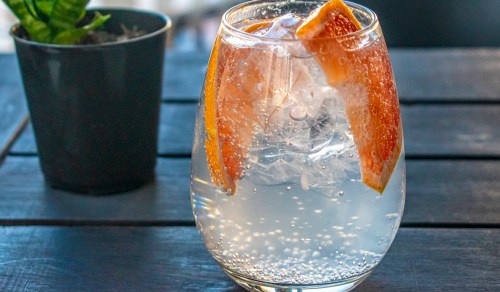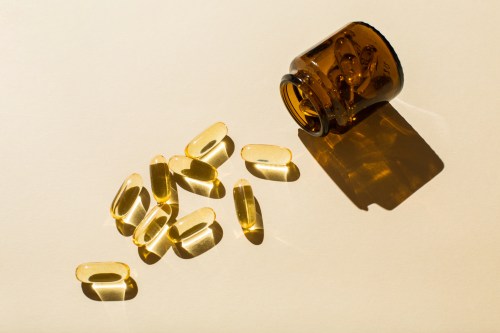Our editors independently select these products. Making a purchase through our links may earn Well+Good a commission
As a healthier alternative to soda and other sugary beverages, sparkling water couldn’t be more on brand. It’s refreshing, tastes great, and gives your H2O some oomph. But nothing is perfect: Too much sparkling water is bad for a sensitive stomach, for instance.
Experts in This Article
food scientist and founder of Abbey The Food Scientist
Professor in the Department of Biochemistry and Molecular Biology at Michigan State University (MSU), Associate Director of the Center for PFAS Research, and Interim Director of the MSU PFAS Analytical Laboratory.
Recently, there’s also been some online chatter about per- and polyfluoralkyl substances (PFAS), aka forever chemicals, in several brands of sparkling water. So, are PFAS in sparkling water safe? What are they doing in your bubbly water to begin with?
Here, we explore what PFAS are, how they can be a health concern, and how prevalent they are in your favorite seltzer and sparkling water brands.
What are PFAS?
“PFAS is an acronym that stands for per- and poly-fluorinated alkyl substances, a group of thousands of different synthetic chemicals that have been produced since the 1940s and are not naturally occurring,” says Arthur Daniel Jones, PhD, professor in the Department of Biochemistry and Molecular Biology at Michigan State University, associate director of the Center for PFAS Research, and interim director of the MSU PFAS Analytical Laboratory.
There are more than 15,000 known PFAS chemicals (so far) today. Many of these chemicals are particularly resistant against natural processes that effectively break down other chemicals. Hence their nickname: “forever chemicals.”
“As a result, they don’t really go away—they just move from one place to another and have spread worldwide, even into the most remote locations, like the Arctic,” Jones explains.
Because of this, PFAS are found in a variety of consumer and industrial products, including sparkling waters and seltzers. How? It’s primarily through the water it’s made with. “Many of these chemicals are slightly soluble in water and are transported through flowing waters such as streams, rivers, and ocean currents,” Jones says. They can also linger in the air and soil, where they can work their way into our food.
“The U.S. Geological Survey recently estimated that 45 percent of the drinking water in the U.S. could have one or more PFAS chemicals,” Jones says. Although manufacturers filter their water before producing sparkling water products, they don’t all have water filters that remove PFAS, says Abbey Thiel, PhD, food scientist, science writer, and Youtuber.
Thiel goes on to explain that these pesky chemicals also contaminate water through manufacturing equipment, where PFAS have been readily used in machine parts production for years. “This means there’s possible contamination for any foods or beverages made on these manufacturing lines, as PFAS can migrate into the products,” she says. Then there’s the element of beverage packaging, which can house a range of PFAS.
The potential health effects of PFAS
While research is just ramping up around understanding whether PFAS are harmful for our health, initial evidence is concerning (to say the least).
“The main concerns so far are increases in blood cholesterol levels, changes in levels of liver enzymes, decreases in infant birth weights, pregnancy-induced hypertension, gestational diabetes and preeclampsia, kidney and testicular cancer, and lower immune responses to vaccines,” Jones explains.
Exposure to PFAS are associated with impaired immune, endocrine, reproductive, and metabolic function, per a March 2021 review in Environmental Toxicology and Chemistry1. Plus, PFAS are a major health concern for wildlife and natural landscapes due to their toxic nature.
Jone also adds that only a small percentage of known PFAS chemicals have been studied, and mostly through animal studies or statistical analyses. This is, in part, due to the fact that it’s unethical to intentionally expose human study participants to dangerous levels of these chemicals and further illustrates just how limited our knowledge is about the effects of these chemicals.
PFAS in sparkling water brands
PFAS are the last ingredient you want to find in your favorite fizzy drink, so if you want to avoid them, you may want to seek out brands that have limited amounts of them. A September 2020 Consumer Reports study tested 47 different brands of water, 12 of which were carbonated. Of these sparkling samples, 11 contained some concentration of the 30 PFAS chemicals they tested for.
The Environmental Protection Agency (EPA) has set a maximum contaminant level (MCL) of 4.0 parts per trillion (ppt) for PFAS in drinking water to be considered safe. However, other environmental advocacy groups have set more stringent limitations, such as the Environmental Working Group (EWG) recommending no more than 1.0 ppt.
Of the tested sparkling water brands, the following contained the most PFAS:
- 1.Topo Chico Natural Mineral Water (9.76 ppt)
- 2.Polar Natural Seltzer Water (6.41 ppt)
- 3.Bubly Blackberry Sparkling Water (2.24 ppt)
- 4.Poland Spring Zesty Lime Sparkling Water (1.66 ppt)
- 5.Canada Dry Lemon Lime Sparkling Seltzer Water (1.24 ppt)
- 6.La Croix Natural Sparkling Water (1.16 ppt)
- 7.Perrier Natural Sparkling Mineral Water (1.1 ppt)
Is drinking sparkling water safe?
So what’s a sparkling water lover to do about this predicament? Thankfully, there are quite a few ways you can enjoy your sparkling water—without the imminent threat of PFAS.
The Consumer Reports study found the lowest amount of PFAS in these sparkling water brands:
- 1.Schweppes Lemon Lime Sparkling Water Beverage (0.58 ppt)
- 2.Dasani Black Cherry Sparkling Water (0.37 ppt)
- 3.San Pellegrino Natural Sparkling Mineral Water (0.31 ppt)
- 4.Spindrift Raspberry Lime Sparkling Water (0.19 ppt)
- 5.Sparkling Ice Black Raspberry Sparkling Water (Not detected)
Also, in response to this study, Topo Chico released a statement in 2021 committing to cutting the PFAS content of its sparkling water in half–though that would still leave them high on the list compared to other brands.
But there are even better ways to avoid PFAS in sparkling water. “If you want to guarantee there’s no PFAS in your sparkling water, I suggest making it yourself,” Thiel says.
She recommends investing in a certified water filter that specifically advertises PFAS removal and sports a certification seal from a reputable testing organization, like NSF or the Water Quality Association. Then simply carbonate that filtered water with an at-home sparkling water maker, like Soda Stream.
The bottom line
While the current sparkling water PFAS situation looks a little bleak, the landscape is actually forecasted to improve. “The EPA recently announced new guidelines for levels of some PFAS chemicals in public drinking water systems, and this will eventually mandate that public water systems periodically measure PFAS levels in drinking water and take measures to reduce PFAS levels to below specified MCLs,” Jones says. This increases the odds that the water used to create sparkling products will be lower in (or free from) PFAS.
And though many fan-favorite brands have been found to contain these dreaded chemicals, there are plenty of actions you can take to avoid them while still enjoying sparkling water, like choosing better brands and making our own. By being a more informed consumer, you can invest in companies and products engaging in thoughtful and ethical product development. We’ll cheers to that!
Fenton SE, Ducatman A, Boobis A, DeWitt JC, Lau C, Ng C, Smith JS, Roberts SM. Per- and Polyfluoroalkyl Substance Toxicity and Human Health Review: Current State of Knowledge and Strategies for Informing Future Research. Environ Toxicol Chem. 2021 Mar;40(3):606-630. doi: 10.1002/etc.4890. Epub 2020 Dec 7. PMID: 33017053; PMCID: PMC7906952.
↩︎
Sign Up for Our Daily Newsletter
Get all the latest in wellness, trends, food, fitness, beauty, and more delivered right to your inbox.
Got it, you've been added to our email list.










